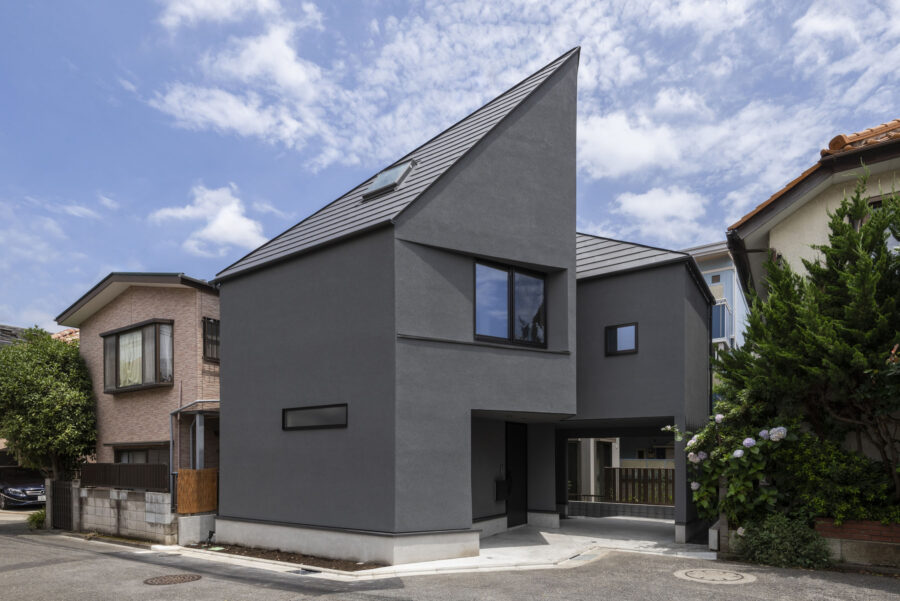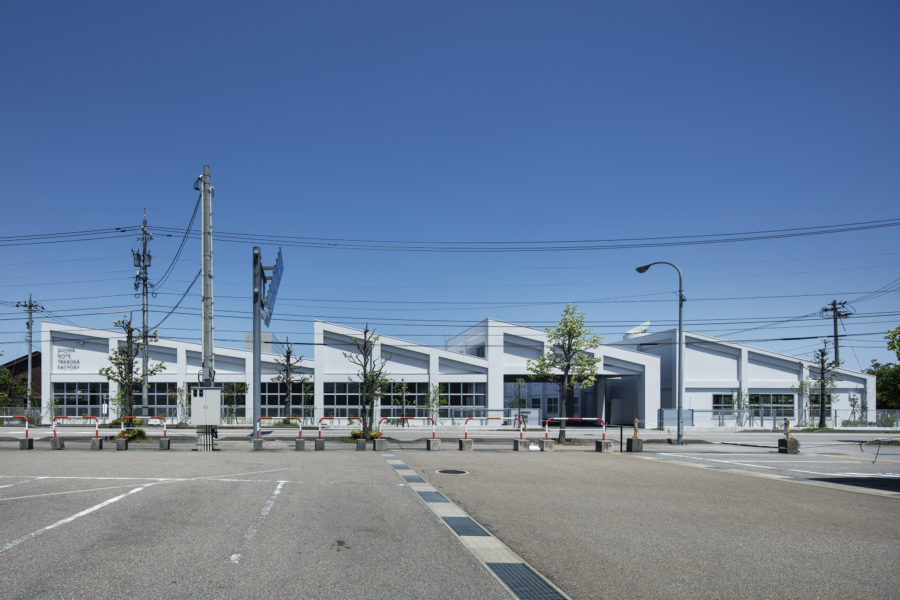川崎市中原区武蔵新城にコワーキングスペースを計画した。
JR南武線武蔵新城駅の北側は、かつて、稲毛領の新しい庄として、二ヶ領用水から引き込まれた水により広く豊かな水田が広がっていた地域である。
現在の街並みは、飲食店が多く並ぶ商店街、賃貸の集合住宅、大型の分譲マンションなどがあるが、昔からこの地に住む地主が地域の特性やつながりを守り、街の構造を保ってきたため、大きなチェーン店などの資本進出が少ない。
昼間人口は多い街で、今のようなリモートワークが盛んとなると、さらに街の活気が増しているように見える。ただ、都心のような仕事のしやすいカフェなどは少ない。
このコワーキングスペースが入る場所は、人通りの多い商店街の中ほどにある鉄骨造4階建ての店舗+共同住宅の2階のフロアである。今春まで地域に愛された中華料理屋とバーの2店舗が営業していたが、新しい業態への更新を行うこととなった。
私たちは、さほど広くはないこの場所で、街とのつながりを感じながら、「はたらくことと暮らすこと」を豊かに、そのために、居心地のよい場所や距離感をつくり出すことを考えた。
居心地のよい場所や距離感をつくり出すためには、多様性と重層性が必要になる。多様な構成をもつ、異なる要素が重なることで、その中に選択的な隙間が生まれ、それぞれの居場所が発見できると考えるからだ。また、居心地のよさの距離は、視覚的な要素がおおいにある。明るさの濃淡、仕切る壁の高さと厚み、植栽の営み、街の気配の取り込みについて、複層的な重なりを検討した。
[明るさの濃淡]
まず、注視したのは、光の環境である。
このフロアにある窓は、ほとんどすべてが真西に向いており、自然光だけでは午前中は暗く、日中であっても建物自体の影によって、環境はさほど変わらない。一方で、オフィス空間によく見られる、照明によって均質に、部屋の隅々まで明るく照らされた空間は、仕事をするうえでは合理的で管理もしやすく都合がよいが、居心地がよいとはいえない。
私たちは、不均質な明暗をつくり出すことによって、居心地のよい距離を獲得できるコワーキングスペースとなることを目指した。作業面の照度は確保しつつ、それ以外の場所の暗さや明るさに濃淡をつけた。ソファラウンジの仄暗さ、視線の高さに感じるペンダントライトの光、植栽に落ちる太陽光のような眩しさ、この場所を利用する人は、明るさの濃淡の中で場所を変えながら、自分の場所を見つけることができる。
[仕切る壁の高さと厚み]
既存建物は雑多な街の空気から、1段階上へ上がることで、静けさや落ち着きを取り戻せる場所であった。
平面は、中央に外部階段を含む吹き抜けをもつことで、南北に大きく2分割される。床はモルタル打設時に着色した粉を散布して仕上げたもので、モルタルそのものの色ムラを拾いつつ、表情が豊かなものとなった。その床を仕切る壁は、さまざまな高さと厚みをもち、素材にはモルタル系の左官材料を使用することで、床から壁が立ち上がったかのような表現を試みている。そのため、バックヤードの諸室以外は、天井まで仕切らず、視覚的には一体的に感じられるようにした。ほんのわずかな欄間が、隔てられた向こう側とこちら側の気配をつなぎ、視線が合いながらもヴォリュームのある壁によって心地よい距離をつくり出した。
[植栽の営み]
ワークスペースの中央には、切り取られた大きな庭をつくった。その上部には、大きな照明(ビッグシェード)を吊るす。明るく照らされた植物は輝き、存在感を増すことで、この街にはない異質感として際立たせた。植栽は、季節の移ろいとともに花をつけ、落葉し、新たな枝を付けるような、自然の生態系に近い野原をイメージしたものとした。そして、立ち入ることができない、アンコントローラブルな状況をつくり出すことで、空間の不均質さはさらに進む。
[街の気配の取り込み]
2階のテナントが街とのつながりをもつためには、リテラルに開くことではなく、間接的な気配や様相のつながりをつくり出すことが必要である。天井を軒天のレベルに合わせて設け、内外を連続的に見せる。その天井の仕上げを全ツヤの塗装とした。すると、街の気配が反射しながら室内に引き込まれ、2階にありながら、商店街の人の移ろいが感じられ、また室内の色がにじみ出る効果が生まれた。
[まとめ]
4年前に武蔵新城に事務所を構えてから、「小さなまちづくり」を続けてきた。この街は、飲食店や美容院、歯科医院など、生活に必要な要素でつくられた、暮らすための街である。
私たちの活動は、マンションの1階に設けたカフェ〈新城テラス〉の内装設計から始まった。入居者交流を目的にしてつくられたカフェではあったが、さまざまなイベントの受け皿となり、現在では地域住人の憩いの場となっている。また、筆者事務所が入居する建物〈第六南荘〉では、道路との境界面を操作した。ブロック塀を解体し、バルコニーの手摺を撤去し、道路側からのアクセスへと変更を行った。その結果、並びにあった1階住戸が店舗へと入れ替わり、建物の1階および周辺全体が街に開かれる公園のような建物となった。この建物では、敷地境界にデッキやベンチ、カウンターを設けたことで、境界線に厚みができ、街の人にとって選択可能な拠り所となっている。
このように小さなまちづくりを面的に広げる中で、このコワーキングスペースのあり方が決まっていった。〈新城テラス〉との連携により、コワーキングスペース内のシェアキッチンの設えはあえてシンプルなものとし、不足となるドロップンインの客席は、〈新城テラス〉の裏にあるイベントスペースを使うようにした。
商店街の中で、異業種であるコワーキングスペースが備わり、認識されると、新しい反応が起きるだろう。リモートワークにより自宅に閉じこもっていたサラリーマンや、個人店で客席の机を使って事務作業をしていた店主が、街の中に現れ、コワーキングスペースを利用し、交わる。街の中でも多様性が生まれるきっかけとなると思う。(藤木俊大、佐屋香織、佐治 卓)
A co-working space that makes the space heterogeneous and brings affluence to the city and people
We planned a co-working space in Musashi-Shinjo, Nakahara-ku, Kawasaki.The north side of Musashi-Shinjo Station on the JR Nambu Line is an area where abundant paddy fields were once spread by the water drawn from Nikaryo Waterway as a new territory in the Inage territory.
The current cityscape includes a shopping district with many restaurants, rental apartments, and large condominiums, but the landowners who have lived in this area have preserved the characteristics and connections of the area and maintained the structure of the city. There are few capital expansions, such as large chain stores. In a city with a large daytime population, it seems that the city is becoming more lively when remote work is now flourishing. However, there are few cafes that are easy to work in, such as in the city center.
The place where this co-working space enters is the second floor of a steel-framed four-story store + apartment building in the middle of a busy shopping street. Until this spring, two restaurants, a Chinese restaurant and a bar, which were loved by the region, were open, but they will be renewed to a new format. We thought about creating a cozy place and a sense of distance to enrich “working and living” while feeling the connection with the city in this not-so-large place.
Diversity and multi-layering are needed to create a cozy place and a sense of distance. By overlapping different elements with various configurations, a selective gap is created in them, and it is thought that each location can be found. Also, the cozy distance has a lot of visual elements. We considered the multi-layered overlap of the shade of brightness, the height, and thickness of the partition walls, the planting activities, and the capture of the signs of the city.
[The shade of brightness]
First of all, I focused on the light environment.
Almost all of the windows on this floor face to the west, and it is dark in the morning with natural light alone, and the environment does not change much even in the daytime due to the shadow of the building itself. On the other hand, the space that is often seen in office spaces and is uniformly illuminated by lighting and brightly lit up in every corner of the room is rational, easy to manage, and convenient for work, but it is not comfortable.
We aimed to create a co-working space where you can get a cozy distance by creating inhomogeneous light and darkness. While ensuring the illuminance on the work surface, the darkness and brightness of other places were shaded. The darkness of the sofa lounge, the light of the pendant light that feels at the height of the line of sight, the glare like the sunlight falling on the planting, people who use this place change the place in the shade of brightness; you can find your place.
[The height and thickness of the partition wall]
The existing building was a place where you could regain tranquility and calm by going up one step from the mixed air of the city. The plane is roughly divided into north and south by having a stairwell including an external staircase in the center. The floor was finished by spraying colored powder on the mortar, and while picking up the uneven color of the mortar itself, the expression was rich. The walls that partition the floor have various heights and thicknesses, and by using mortar-based plastering material as the material, we are trying to express it as if the wall had grown from the floor. For this reason, except for the rooms in the backyard, the ceiling is not partitioned so that it can be visually felt like one. We created a comfortable distance with a wall that has a volume while looking at each other.
[Planting activities]
In the center of the workspace, we created a garden that looks like it was cut out from the outside. A large light “Big Shade” is hung above it. The brightly lit plants shine and increase their presence, making them stand out as a unique texture not found in the city. The planting was based on the image of a field close to the natural ecosystem, with flowers, defoliation, and new branches as the seasons change. And by creating an uncontrollable situation that is inaccessible, the inhomogeneity of space goes further.
[Taking in the signs of the city]
In order for the tenants on the second floor to have a connection with the city, we felt that it was better to create an indirect signs and aspects connection rather than opening it literally. The ceiling is set according to the level of the eaves, and the inside and outside are shown continuously. The finish of the ceiling was full gloss paint. Then, the sign of the city was reflected and drawn into the room, and although it was on the second floor, the change of people in the shopping district was felt, and the color of the room oozes out.
[at the end]
Since setting up an office in Musashi-Shinjo four years ago, he has continued to “small-town development.” This town is a town for living, made up of elements necessary for daily life, such as restaurants, beauty salons, and dental clinics. Our activity began with the interior design of the cafe 〈Shinjo Terrace〉 on the first floor of the condominium. Although it was a cafe created for the purpose of resident exchange, it has become a place for various events and is now a place of relaxation for local residents. In addition, in the building where our office is located 〈No. 6 Minamisou〉, the boundary surface with the road was operated. The block wall was dismantled, the balcony railing was removed, and the access was changed from the roadside. As a result, the existing first-floor dwelling units were replaced with stores, and the first floor of the building and the entire surrounding area became a park-like building that was open to the city. In this building, decks, benches, and counters are installed on the boundary of the site, which makes the boundary thicker and is a base of choice for the people of the city. The ideal way of this co-working space was decided while expanding the small-town development in this way. In collaboration with 〈Shinjo Terrace〉, the shared kitchen in the co-working space was intentionally made simple, and the event space behind 〈Shinjo Terrace〉 was used for the shortage of drop-in seats.
In the shopping district, there will be a co-working space in a different industry, and when it is recognized, a new reaction will occur. Office workers who were locked up at home by remote work and shopkeepers who were working at private stores using desks in the audience seats appeared in the city and used the co-working space to meet. I think it will be an opportunity for diversity to be born in the city. (Shunta Fujiki, Kaori Saya, Taku Saji)
【武蔵新城のコワーキングスペース】
所在地:神奈川県川崎市
用途:シェアオフィス、コワーキングスペース
クライアント:南荘石井事務所
竣工:2020年
設計:PEAK STUDIO
担当:藤木俊大、佐屋香織、佐治 卓
照明計画:大友恒人(DAIYU)
植栽計画:會澤佐恵子(AWAI design)
施工:コーケン
撮影:高橋菜生
工事種別:リノベーション
構造:鉄筋コンクリート造
規模:地上4階建て・2階部分
敷地面積:182.96m²
建築面積:161.98m²
延床面積:531.75m²
施工床面積:135.00m²(2階部分)
設計期間:2020.01-2020.05
施工期間:2020.06-2020.10
【Co-working space in Musashi-Shinjo】
Location: Kawasaki-shi, Kanagawa, Japan
Principal use: Share office, Co-working space
Client: MINAMISO ISHII JIMUSYO
Completion: 2020
Architects: PEAK STUDIO
Design team: Shunta Fujiki, Kaori Saya, Taku Saji
Lighting design: Hisato Otomo / DAIYU
Planting design: Saeko Aizawa / AWAI design
Contractor: Koken
Photographs: Nao Takahashi
Construction type: Renovation
Main structure: Reinforced Concrete construction
Building scale: 4 stories 2nd floor
Site area: 182.96m²
Building area: 161.98m²
Total floor area: 531.75m²
Construction floor area: 135.00m² (2nd floor)
Design term: 2020.01-2020.05
Construction term: 2020.06-2020.10








